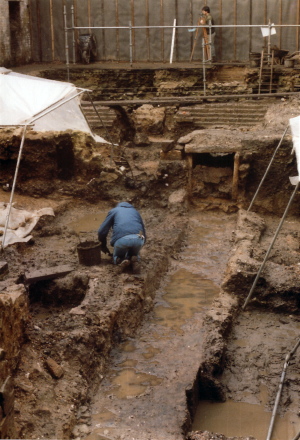Excavation
|
|
For excavation in civil engineering see earthworks (engineering).
Excavation is the best-known and most commonly used technique within the science of archaeology. Individual excavations are normally referred to simply as "digs" by those who participate, this being an over-literal description of the process. An excavation concerns itself with a specific archaeological site or connected series of sites, and may be carried on over a number of years, since the work tends to be seasonal.
Within the practice of excavation, many more specialised techniques may be used, and each dig will have its particular features which may necessitate differences of approach. Resources and other practical issues do not allow archaeologists to carry out excavations whenever and wherever they choose; many known sites have been deliberately left unexcavated. This is with the intention of preserving them for future generations as well as recognising the role they serve in the communities that live near them. In some cases it is also hoped that improvements in technology will enable them to be re-examined at a later date, with more fruitful results. It is beginning to be predicted that the time will come when the process of excavation becomes completely redundant, as archaeologists will be able to make an assessment of what lies under the surface of a site without actually having to dig it up. This is a distant proposition however as although the presence or absence of archaeological remains can sometimes be suggested by remote sensing, such as ground-penetrating radar, the understanding of features and retrieval of artefacts can only be undertaken through invasive methods.
Excavation initially involves the removal of any topsoil overburden by machine. This material may be examined by metal detector for stray finds but unless the site has remained untouched since its abandonment there is invariably a layer of modern material on the surface of limited archaeological interest. In rural areas, any archaeological features should then be visible beneath the surface. In urban areas there may be thick layers of human deposits and only the uppermost will be initially visible. In either case, the first task is to draw a scaled site plan showing the edges of the excavation and the extents of the features. This plan may be made using tape measures, or as is more common using an electronic Total station. A strategy for sampling the features can then be formulated which may involve total excavation of each feature or only portions. It is normal to excavate the latest features first and the earliest features last. A grid is usually set up, dividing the site into 5m squares to better aid the positioning of the features on the overall site plan. In urban archaeology this grid becomes invaluable for implementing single context recording.
Each excavated feature is recorded through being drawn in plan and section. It is also photographed and each context is given a number to aid later interpretation. Finds from each context are bagged and labelled with their context as well as a unique site code. Recording sheets are filled in to describe the contexts. The height of each feature is related to the site benchmark. Samples from features are also taken, for later environmental analysis or for scientific dating.
A group of archaeological excavators will generally work for a supervisor who reports to the site director or project manager. He or she will have ultimate responsibility for interpreting the site and writing the final report. Most excavations are eventually published in professional journals although this process can take years.
Excavation types
There are three types of modern archaeological excavation:
- Research excavation - when time and resources are available to excavate the site fully and at a leisurely pace. These are now almost exclusively the preserve of academics or private societies who can muster enough volunteer labour and funds. The size of the excavation can also be decided by the director as it goes on.
- Development-led excavation - undertaken by professional archaeologists when the site is threatened by building development. Normally funded by the developer meaning that time is more of a factor as well as it being focused only on areas to be affected by building. The workforce is generally more skilled however and pre-development excavations also provide a comprehensive record of the areas investigated.
- Rescue excavation - when the site has already been damaged, eg. by erosion, time is extremely limited and the excavation becomes a damage limitation exercise. Usually funded by the state and undertaken by commercial archaeologists.
Ongoing digs must number into the thousands, if not more. For a list of archaeological sites by country, see List of famous archaeological sites and List of archaeological sites .ja:発掘調査 de:Ausgrabung

